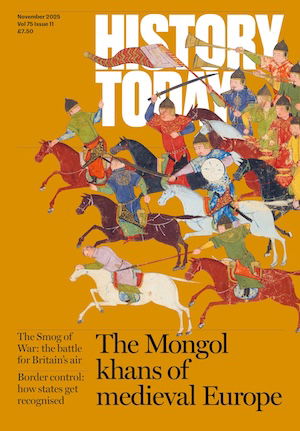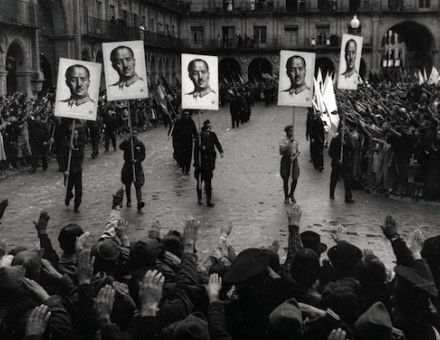Essays with Commentaries
Richard Hughes lends us the benefit of his expertise.
While the two short essays (with comments) which follow are based specifically on the requirements needed for Edexcel AS Unit 2, they do illustrate issues applicable to all structured history essays.
The Questions
A structured essay always requires a candidate to make maximum use of the limited length of time provided. Anyone who strays into unnecessary diversion is likely to lose marks. The first essay tests descriptive skills and has a maximum mark of 20; the second essay places the focus on causation and has a maximum mark of 40. With (a), the descriptive question, the top level of marks is awarded to candidates able to establish explicit links to the question. In other words, the relevance of the points raised must be made obvious to the examiner. The same applies to (b) where, in addition, a high-achieving candidate will be expected to display integration – how the causal points link together with some sort of overview being offered. It is important with all questions to adhere to the assessment objectives – less prepared candidates all too often mix them up and so emphasise causal links in (a) and not (b), and descriptions in (b) and not (a). This will inevitably mean the examiner has to reward such students with the lowest bands.
The Rubric
Below is an example of the type of question that might be set as a structured essay on a key theme of the reign of Charles I. The first point to stress here is that neither of the responses is all-encompassing. Any student with a fair knowledge of the chosen period will think of relevant points not included here. The examiner does not want or expect a heavily detailed response – impossible anyway in the time provided. What is required is sufficient factual support for the points made. The student needs to take note of the mark tariff. It is extraordinary how many students give equal amounts of time to both questions even though (b) awards twice as many marks as (a). It is unrealistic to be too prescriptive about time allocation, but with a total time of 55 minutes, the following breakdown is recommended: five minutes for reading and planning; 15-20 minutes for (a) and, most important, at least half an hour for (b) is recommended.
The questions here are straightforward. Anyone with a basic factual groundwork will be familiar with the material. What the examiner is searching for is evidence to show that the student can use the material and not just recall it.
The Examples
‘What Measures did Charles I Take To Strengthen Royal Finances during the Period 1629-1640?’
Charles I took a number of measures to strengthen royal finances during the Personal Rule. In order to ensure that his government could survive without the need to summon parliament, he had to find alternative methods of funding to replace parliamentary taxation. He also needed to avoid a costly foreign policy, which would impose a huge financial burden on his resources and limit customs revenue and foreign trade. He also needed to ensure effective administration to prevent his income being wasted in extravagance and corruption.
[While this paragraph is essentially about why Charles did what he did – so might be criticised for being a little off-focus – it is a succinct setting of the scene. It is also refreshing in that it shows that the essay will be more than a list of fiscal measures – often a problem with this topic.]
To find alternative methods of finance, Charles made full use of his Attorney-General, William Noy, who recommended several financial devices which, though fallen into disuse, were technically within the law. In this way, the King could not be accused of inventing new systems of finance whose dubious legality might encourage resistance. In this category were distraint of knighthood and forest fines. In addition, Charles continued to collect tonnage and poundage and he sold monopolies, getting round the anti-monopoly legislation of 1624 by selling them to groups of people rather than to individuals. The most famous of Charles’ initiatives was Ship Money, funds to finance the construction of ships in wartime, which Charles extended to the whole country and then made into a regular form of taxation. (Previously Ship Money had been an occasional tax imposed on coastal areas.)
[It would be easy to write much more here. Charles’ financial devices are a magnet for the conscientious student who is capable of writing much descriptive material on this theme. This paragraph just deals with the essence. More substance might be in order here, but it is important to remember the time factor and there are lots more interesting points to consider.]
Charles dealt with the financial burden of a costly foreign policy by swiftly making peace with France (Treaty of Susa, 1629) and Spain (Treaty of Madrid, 1630). These foreign policy adventures had been a massive drain on his resources, so their conclusion was a huge boost to royal finances. Peace also encouraged overseas trade and expanded customs revenue.
[Many students ignore this aspect, so its inclusion will impress the examiner. This shows an awareness that financial policy is about reducing expenditure as well as raising revenue.]
Charles was served by some able administrators who tried, with mixed success, to keep a check on extravagance and corruption. The term ‘Thorough’ is used to describe the centralising policies associated with the Personal Rule, and there was a real effort to ensure that the government in London kept firm control on what was occurring in the provinces. Sir Richard Weston, Lord Treasurer till 1635, and Sir Francis Cottington, Chancellor of the Exchequer, had some success in overseeing sound administration. Sir Thomas Wentworth’s harsh regime in Ireland turned the province from a financial liability costing the crown in excess of £20,000 a year in the early 1630s, to a financial asset by the late 1630s. So the King’s finances were strengthened by a series of policies pursued by his advisors.
[As with the consideration of foreign policy, the topic of administration is often ignored, so its inclusion should impress the examiner. Charles’ administrators – notably Wentworth – are usually viewed in a negative context, so this is a sort of ‘positive spin’ which is quite refreshing.]
So with these measures and the people in charge of implementing them, Charles did strengthen royal finances to the extent that by 1638 royal income matched royal expenditure for the first time in close on two centuries. But there was a huge political cost. The strength of the King’s financial situation was dependent on peace, which could never be guaranteed, and the connivance of the traditional groups in the provinces who quickly became alienated by Charles’ policies.
[There is some overview and comment here – kept brief because the emphasis needs to be on description. But it brings together the points and there is some reflection on the material.]
‘Why Was Opposition to Charles I’s Personal Rule so Widespread by 1640?’
There were several reasons why opposition to Charles I’s Personal Rule was so widespread by 1640. First, the financial methods he used to fund the government provoked increasing resentment from the tax-paying and tax-collecting community. These financial methods were resented because they were considered illegal – the King was expected to go through parliament for his additional revenue. They were also resented because they seemed to be working – and if they worked, then Charles might successfully establish an absolutist monarchy like those of France and Spain. (This fear was also encouraged by several of Charles’ policies, namely the religious changes associated with William Laud and the tough regime in Ireland administered by Wentworth; the high profile of Henrietta Maria, Charles’ French and Roman Catholic wife, also provoked suspicion and hostility, particularly in the midst of the Thirty Years War, which was seen by many English as a straightforward conflict between ‘good’ Protestants and ‘bad’ Catholics.)
[This paragraph gets the topic under way and starts to enumerate the relevant causal points. It provides a European context – not always done and very refreshing when it appears.]
Charles’ financial policy was also resented by those who had responsibility for collecting the legally dubious taxes. This was particularly so with the sheriffs of the counties, who became personally responsible for any shortfall in the collection of the controversial Ship Money – thus, by simply trying to carry out their patriotic duty, they could face financial ruin. Even when Ship Money was deemed legal after the Hampden Case of 1637, this verdict served only to increase the extent of the opposition, for the closeness of the verdict encouraged the opponents and the fact that Ship Money was now an official tax rather than an occasional contribution towards security widened resentment towards it.
[Here is another point not always raised, but is nevertheless extremely important – the alienation of the tax collectors. The paragraph also makes a good point about the long-term impact of the Hampden trial.]
Charles’ religious policy also provoked widespread hostility. There was hostility from religious moderates who saw the King and his Archbishop, William Laud, as breaking the protestant consensus by supporting the anti-Calvinist theology of the Dutch thinker Arminius, and by introducing Roman Catholic notions of images and idolatry into the churches. The increased status of the clergy, notably the high profile given to bishops, was particularly resented by the old ruling elite. The appointment of William Juxon, Bishop of London and close associate of Laud, to the Lord Treasurer’s post in 1635 was ill received. Laud’s attack on the protestant-minded feoffees for impropriations and his desire to see sermons replaced by catechisms were all regarded as an attack on accepted protestant practice. Laud’s image was not enhanced when the Pope unhelpfully offered him a Cardinal’s hat; his vehement rejection of the offer failed to quell disquiet.
[Religious policy, is a topic that sometimes submerges the conscientious student who has revised well. For this topic, what is needed is a link between religion and unpopularity and this paragraph touches on three essential aspects – theological, clerical and Papal fears.]
There was resentment, too, at the power Laud exercised through the prerogative Courts, Star Chamber and High Commission. The legal profession took particular exception to this. There was widespread anger at the harsh sentences imposed upon the Puritan pamphleteers, Prynne, Bastwicke and Burton, in 1637. A factor underpinning this anger was outrage that educated members of the gentry class should be punished in a manner suitable only for the lower orders – made worse when this punishment was on the instruction of Laud, the son of a Reading draper.
[The fate of the Puritan pamphleteers is a popular topic, but what needs to be emphasised is what it illustrates – Laud’s harshness, the unpopularity of the prerogative Courts, and the social resentment felt towards Laud by the gentry.]
So there were several factors behind the opposition to Charles’ Personal Rule, with the consequence that the opposition was very widespread, encompassing financial, religious, constitutional and social factors. Until the late 1630s there was, perhaps above all, fear that the new system might succeed – and in Ireland there seemed to be a model in place in the form of Strafford’s uncompromising regime. But Charles had alienated the traditional ruling elite so much, had offered so much ammunition for his more extreme opponents to use against him, that one major external circumstance, namely the war with Scotland, would expose just how fragile was the edifice which he had constructed.
[Here is an attempt at integration – bringing the points together to achieve an overview. Students who attempt to do this will impress the examiner.]
These brief essays are by no means ‘model’ responses. Yet they are the sort of answers that would achieve high marks: they focus on the questions set and they include no unnecessary padding.




